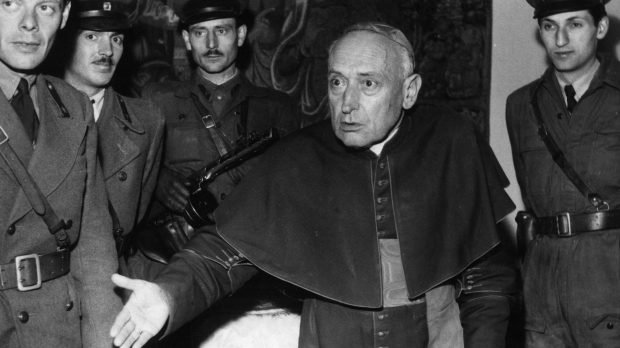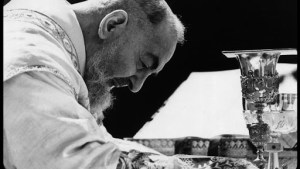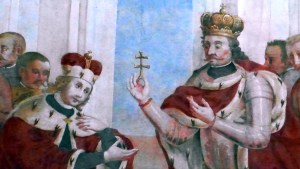Pope Francis’ trip to Hungary from April 28 to 30, 2023, is an opportunity to look at the figure of Cardinal Jószef Mindszenty (1882-1975), primate of Hungary from 1945 to 1974 and a central figure in the resistance to communism.
Arrested on Boxing Day 1948 and sentenced to life imprisonment at a trial held the following year, the Archbishop of Esztergom-Budapest was the victim of torture and psychological pressure before being released during the brief interlude of relaxation of the Hungarian regime in 1956. Soviet intervention forced him to take refuge in the U.S. Embassy in Budapest, where he remained for 15 years.
After his exfiltration in 1971, he lived in exile in Austria, making numerous trips to the Hungarian diaspora around the world. However, he was asked by the Holy See to renounce his office as part of Ostpolitik. This new policy, embodied by Archbishop Agostino Casaroli, then Secretary of the Council for Public Affairs of the Church — who would later become a cardinal and Secretary of State under John Paul II — consisted of seeking a way of “getting along” with the Communist regimes to allow the Church to resume certain activities, even if it meant appointing bishops who were more conciliatory with the regime. This decision is still the subject of heated debate, with Rome accused of having “sacrificed” a Christian hero in the name of raison d’état.
An investigation for his beatification was opened in 1994, and Pope Francis formally recognized his heroic virtues 25 years later, on February 12, 2019. EduardHabsburg, Hungarian ambassador to the Holy See and president of the Foundation for the Beatification of Cardinal Mindszenty, looks back at the journey of the former primate, who remained very popular in this Central European country and beyond.
How is Cardinal Mindszenty perceived today in Hungary? Is he known by the younger generation?
Habsburg: We know that between 1 and 1.5 million Hungarians pray every day for the beatification of Cardinal Mindszenty. There is great enthusiasm for him among the population, and he’s known as a hero among the youth. Statues and schools are named after him, and there are even contests for children organized around his personage.
His autobiography has been widely distributed in Hungary and throughout the world, and it has especially made known the historical events, his time in prison, his persecution during the communist era. But I would like the side of him as a man of faith to be better known. The risk is that his aspect as a hero in the struggle against Nazism and Communism can overshadow his spiritual dimension, his character as a holy man, as a bishop who shone with his pastoral work in Hungary.
He had also been imprisoned as a young priest in 1919, under the regime of the “Republic of Councils,” his first experience of this kind resulting from communism. Can we say that his priesthood, from the very beginning, was part of a dynamic of martyrdom and resistance?
Habsburg: Absolutely. What I like most about Mindszenty is his constant resistance, against Nazism as well as against communism. He’s an example for the fight against these regimes. His whole vocation was forged in the fire! He was an extraordinary man, as all those who knew him can testify.
In the photos, we see a man marked by suffering. He spent years in prison. He was tortured, and not only during his great trial. He was martyred. He also spent a very long time in prison, and then for 15 years he was in a vacuum, unable to leave the American embassy. But this didn’t destroy him or make him aggressive. He remained a pastor and a great spiritual man.
He was a man who prayed a lot and who wrote about the Virgin Mary. During Lent, even as a bishop and cardinal, every Wednesday and Friday he fasted on bread and water and slept on the floor as a sign of penance and humility.
Through the beatings and humiliations he received, did he identify himself with Christ in his Passion?
Habsburg: As Christians, we always hope to be able to identify with him. What touched me most in his memoirs was the passage in which he explains that it was in prison, with the experience of torture, that he first really understood the Psalms, which he prayed every day with his priestly breviary. He was able to relate to the suffering that is expressed in the Psalms, to being abandoned … These passages relate to the suffering of Christ, because we know that the Lord prayed these Psalms of suffering on the cross. Cardinal Mindszenty was very aware of this.
During his captivity, did he feel abandoned by some of his fellow bishops and priests, those who had had a conciliatory attitude towards the regime?
Habsburg: It’s a delicate question, because living in a totalitarian regime always implies an inner tension between responsibility towards believers and compromises with the State … It’s always a very complicated situation. Cardinal Mindszenty took the path of martyrdom, of very clear witness, of suffering. But very often we look for black or white where there is mostly gray.
I myself, in the place of these bishops, I who am of a conciliatory temperament: Would I have sought a compromise, or would I have had the courage to say, “Kill me?” Or would I have been instructed by Rome to seek an agreement with the regime? Nothing is simple in such situations.
It’s the same with the Vatican’s Ostpolitik. Pius XII had publicly excommunicated those who had contributed to the arrest of Mindszenty. With John XXIII and then Paul VI, with Cardinal Casaroli, there was a change of approach and a willingness to dialogue with the regime. Were they right or wrong? It’s so difficult to know …
Some people think that it was a catastrophe, that the Vatican abandoned the heroes who had resisted. But we can hear other arguments to the effect that these agreements were the only way for the Church to survive. I think a judgment on that will be made in a century, not now. But Cardinal Mindszenty was very clear in his own journey.
He was confined to the American Embassy in Budapest from 1956 to 1971, and so was not able to participate in the Second Vatican Council. Do we know how he viewed this event?
Habsburg: He wasn’t able to participate in the debates, but we know that he welcomed the liturgical reform and the possibility of celebrating Mass in his own Hungarian language. Photos show that even inside the American embassy he celebrated the Eucharist according to the Missal of Paul VI.
After his exfiltration in 1971 and his passage through Rome, he suffered from the position of the Holy See towards the regime. What was his relationship with Paul VI during this period?
Habsburg: Cardinal Mindszenty, in his exile, became a problem for the Holy See, which wanted to appoint a new primate to ensure the continuity of local pastoral work. As a canonist, he did not want to give up his title — not because of personal attachment, but because he considered it to be the last element of legality from pre-communist Hungary. So there were many negotiations between Paul VI, Archbishop Casaroli, and Cardinal Mindszenty, who was in exile in Vienna at the time.
The cardinal wrote letters to explain his refusal to resign, despite Paul VI’s requests to do so. Archbishop Casaroli ended up announcing Cardinal Mindszenty’s resignation himself, speaking in the official Vatican media, although Paul VI had left a handwritten note in the margin of a letter from the primate, acknowledging that his arguments carried weight and suggesting that there was still room for negotiation … I think, therefore, that there were tensions between Cardinal Mindszenty and Archbishop Casaroli rather than with Paul VI, who had promised him that he would not lose his title. The context was very complicated. But Cardinal Mindszenty was an obedient son of the Church and did not use the title afterwards.
Did he take advantage of his newfound freedom, after more than 20 years of limitations, to plead for religious freedom and denounce the persecutions in his country?
Habsburg: During this difficult period of the early 1970s, he traveled extensively throughout the world, meeting with Hungarian communities and celebrating many confirmations. He was a true pastor. I’ve met many people who were marked by their meeting with Cardinal Mindszenty during these celebrations. The Holy See, the Hungarian bishops, and of course the Hungarian government were worried about his foreign tours, but he spoke only about faith, very carefully, so as not to create problems. He behaved with dignity, in a very impressive way.
He died in 1975 in Vienna of a heart attack after an operation. Naturally, his death received very little publicity in communist Hungary. But the circumstances of his death could be taken into account for his beatification, because a document dating from his captivity showed that he had heart problems related to the mistreatment he received. This data could therefore be considered for a “white martyrdom,” a gift of his life until death. Although he did not die in captivity, his heart was worn out from prison.
How was he perceived in the 1980s and 1990s?
Habsburg: Cardinal Mindszenty was present in everyone’s hearts and memories. But he was seen as both a hero and a difficult character: Even in the Vatican he was respected, but he was also seen as the one who had resisted the Pope. That’s why his beatification process was difficult to start. Today he’s truly recognized as a hero, and I think his beatification will come in the near future. But I hope that people will discover the saintly man above all, and not only the hero.
I remember once asking a priest, a Hungarian Dominican who had known him well, if he considered him a saint. He said yes, because he had been touched by the way he celebrated Mass. Just that. So I would really like him to be recognized as a saint whom we can ask for intercession, and not only as an icon of the resistance.
Pope Francis paid tribute to him in his address to the Hungarian bishops in 2021, during his first visit to Budapest. What is his perception of Cardinal Mindszenty?
Habsburg: Together with another leader of the Foundation, we presented him with a relic in St. Peter’s Square after a general audience, and he told us clearly: “He is a martyr.” His personal view of Cardinal Mindszenty was shaped by Hungarian nuns he knew in Buenos Aires, where they had gone into exile after the 1956 repression. They spoke of Cardinal Mindszenty as a hero.
He was particularly struck by an annotation under a confession letter, in which Cardinal Mindszenty had added the letters “CF,” which stood for “Coactus feci,” “I did it under coercion,” which of course took away all value from the confession. The Pope thought that was fantastic, very clever of him. I think he considers him a hero, that he has great personal sympathy for him. So I would love to see the beatification of Mindszenty happen under his pontificate. I don’t know if it will be possible, but the Lord is doing his work, and I think it will happen in the near future.



